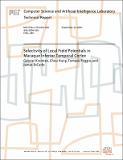Selectivity of Local Field Potentials in Macaque Inferior Temporal Cortex
Author(s)
Kreiman, Gabriel; Hung, Chou; Poggio, Tomaso; DiCarlo, James
DownloadMIT-CSAIL-TR-2004-056.ps (147.4Mb)
Additional downloads
Metadata
Show full item recordAbstract
While single neurons in inferior temporal (IT) cortex show differential responses to distinct complex stimuli, little is known about the responses of populations of neurons in IT. We recorded single electrode data, including multi-unit activity (MUA) and local field potentials (LFP), from 618 sites in the inferior temporal cortex of macaque monkeys while the animals passively viewed 78 different pictures of complex stimuli. The LFPs were obtained by low-pass filtering the extracellular electrophysiological signal with a corner frequency of 300 Hz. As reported previously, we observed that spike counts from MUA showed selectivity for some of the pictures. Strikingly, the LFP data, which is thought to constitute an average over large numbers of neurons, also showed significantly selective responses. The LFP responses were less selective than the MUA responses both in terms of the proportion of selective sites as well as in the selectivity of each site. We observed that there was only little overlap between the selectivity of MUA and LFP recordings from the same electrode. To assess the spatial organization of selective responses, we compared the selectivity of nearby sites recorded along the same penetration and sites recorded from different penetrations. We observed that MUA selectivity was correlated on spatial scales up to 800 m while the LFP selectivity was correlated over a larger spatial extent, with significant correlations between sites separated by several mm. Our data support the idea that there is some topographical arrangement to the organization of selectivity in inferior temporal cortex and that this organization may be relevant for the representation of object identity in IT.
Date issued
2004-09-21Other identifiers
MIT-CSAIL-TR-2004-056
AIM-2004-020
CBCL-240
Series/Report no.
Massachusetts Institute of Technology Computer Science and Artificial Intelligence Laboratory
Keywords
AI, object recognition, inferior temporal cortex, local field potentials